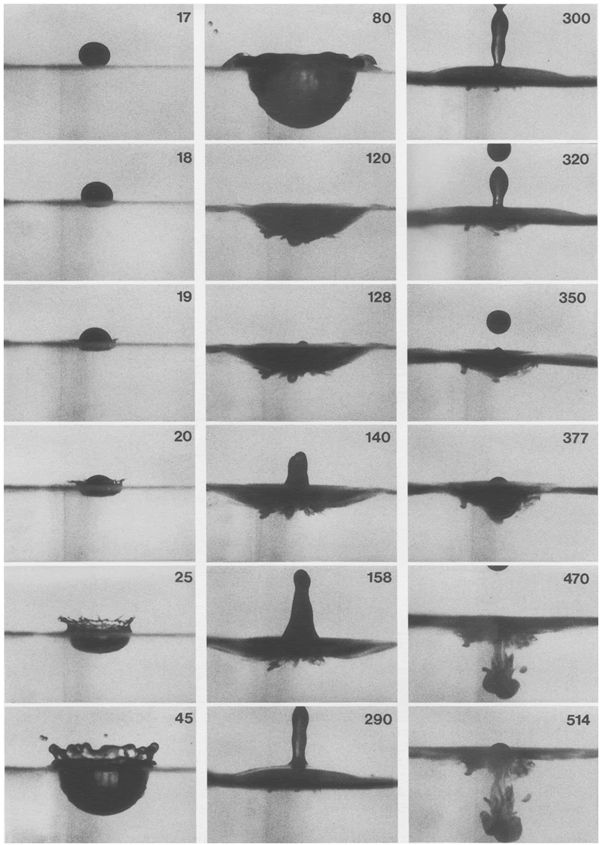When a drop of water impacts onto a liquid surface 'pool' of water, we can observer theone or more phenomena of 'bouncing', 'coalescence' and 'splashing'.:
- The drop 'bounces' then 'floats' the surface of the pool.
- The drop 'coalesces' into the pool.
- The drop 'splashes' on the pool, creating a 'crown' around a 'crater'.
Which will occur depends upon the size and velocity of the droplet. Specifically, the collision can be characterised by the ratio of the inertial forces to the surface force, given by the (dimensionless) Weber number, $We$ defines as:
$$We=\frac{\rho v^2 d}{\sigma}$$
where $\rho$ is the density of the droplet, $v$ is the velocity and $d$ is droplet diameter and $\sigma$ is the surface tension of the droplet fluid.
When the $We$ is above a threshold of $\approx 84$, the impact is characterised as a 'splashing', whereby a 'crown' is formed around the crater and a column of water rises from the middle.1
In order to determine whether the original drop is present in the 'recoiled' water, a series of photos were taken at successive time intervals 0.0003s apart, using a 4.83mm diameter drop (with coloured dye) dropped from a height of 175mm into a transparent pool of water. The number in the corner of each photo represents the sequence number of the photo (at 0.0003s intervals).

As can be seen from these photos, the colour dye is present in the water jets which recoil off the surface of the transparent pool water. However, not all of the water in the jets is from the coloured drop. Some of the original drop is trapped in a pocket below the surface, with the rebounding 'jets' having a 'coating' of the original drop material. The way we know this is because in the experiment, the coloured drop was made from water mixed with thymol blue, an indicator which is dark orange in colour at neutral-to-acidic pH. The pool water contained 0.1% sodium carbonate (alkali), which is transparent in colour, but when the two combined, the mixture turns blue in colour.
Some fascinating insight into the phenomenon can be gained by examining some high speed video footage.
If you look at this high speed video, you will see that when the water droplet falls into the water, it appears to bounce back out!
An even better example of the 'bouncing' phenonenon can be found in this video, when the drop is released gently from close to the surface of the water, it appears that after the drop is 'coalesced' into the water, part of it 'bounces' back out as a smaller droplet, which the falls back and floats on the surface of the water.
The explanation offered is that a layer of air gets trapped beneath the droplet as it hits the surface of the water. Some of the water in the droplet gets coalesced into the pool by the water tension, releasing a smaller droplet back out.
